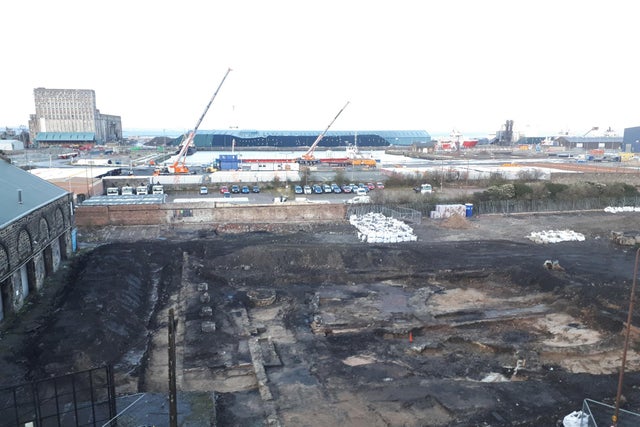Traces of 18th-Century Glass Factory Uncovered in Scotland
Interesting traces of Leith’s glass-making past are being uncovered as preparatory works to construct a new residential development gather steam.
The City of Edinburgh Council lodged proposals by Barratt Homes to develop 212 new apartments plus commercial units on a former industrial land stretch near Leith Docks at Salamander Lane. two years ago and are currently at the consultation stage.
Work is already underway to prepare the site ahead of full planning approval, with a number of buildings that were once home to Garland and Roger Ltd timber yard and a six-metre-high boundary wall cleared at the start of the year.
Workers and archaeologists are now starting to uncover traces of an almost extinct Leith industry which has flourished for centuries and was even responsible for the naming of the road on which it was situated.
There was evidence of the once enormous glasswork in Salamander Lane, which can trace its origins from more than two and a half centuries to 1747.

Aerial photographs show the re-emergence of what’s left of one of the glassworks’ six huge furnace cones as well as a number of other buildings, including workshop and warehouse remains.
The furnace cones measured between 80 and 100 feet in height with a diameter of around 40 feet at the base. The brick-built sixsome towered above the Leith skyline at the time and could be easily spotted from the slopes of Calton Hill more than two miles away.
Archaeologists are currently on-site examining the glassworks buildings and deep layers of ancient beach sand deposits that have been exposed as a result of the excavation. John Lawson, the City of Edinburgh Council’s Archaeologist, said his team is hopeful of uncovering important artefacts during the dig.

He said: “Archaeological investigations have just started on the site which once housed the nationally significant Edinburgh and Leith Glass Works and formed an iconic element of Leith’s industrial skyline.
“It is hoped that the excavations will reveal important evidence as to its development since it moved to this site in the mid 18th Century.”

From the 14th century onwards, Leith boasted trading links with Europe and the world, importing and exporting a wide range of shipments. Alcohol was among the most sought after produce being brought in and the harbour was regularly flooded with casks and barrels of fine French wine, sweet Spanish sherry and Portuguese port.
Leith’s growing whisky industry and Edinburgh being a burgeoning centre for medicine meant an increasing demand for glass products, further underlining the need for a dedicated glassware and bottling works. As chance would have it, the old port was the perfect home for such an industry as the district boasted substantial quantities of sand and kelp – both of which were essential in glass manufacturing during the Georgian era.
Following the opening of earlier works elsewhere at Leith Citadel and in Edinburgh, the first furnace at what would become the Edinburgh and Leith Glass Works on Salamander Street was fired up in 1747. The works opened on the border of what was then Leith Sands, which, for more than 200 years, was home to Scotland’s main horse racing event, the infamous Leith Races.
A total of six giant, brick-built cones had risen from the site by 1783 and would continue to belch out fire and smoke for the best part of the next century. The amphibian-sounding Salamander Street appeared on maps in the early 19th century and was even coined, it is thought, as an allusion to the glass-making industry – the salamander being supposedly fire-proof, according to medieval legend.
At its height, the glassworks had a lot of bottles, producing in excess of one million glass vessels per week – but it wouldn’t last forever. Editions of The Scotsman dating from 1874 record that the dissolution of the Edinburgh and Leith Glass Works Company occurred in December of that year.
The site was put up for lease and the entire plant, stock and materials of the glassworks, which included a 6-horse power horizontal steam engine; a grinding mill; a “first-class nearly new” turning lathe; and all manner of pot-boards; tank rings and “bottle moulds of ever variety from flasks to carboys”, were listed for auction.
Local Blue Badge tourist guide and historian Fraser Parkinson says he hopes chiefs of the ongoing residential development are respectful of the history being uncovered.
He said: “The glass making industry had a strong footing in Leith until the second half of the 19th century, so it is really exciting to be able to view the footprint of the old glass making buildings and especially the foundations of the old cones which could be seen from Calton Hill.
“It’s a brief but appreciated glimpse back in time. Let’s hope that the developers make good recordings of what is unearthed before moving onto Leith’s future buildings.”
The last of the glass works’ furnace cones was demolished in 1912. The timber yard of Garland & Rogers Ltd filled the space in the decades that followed, as one by one Leith’s traditional industries slowly began to disappear.
